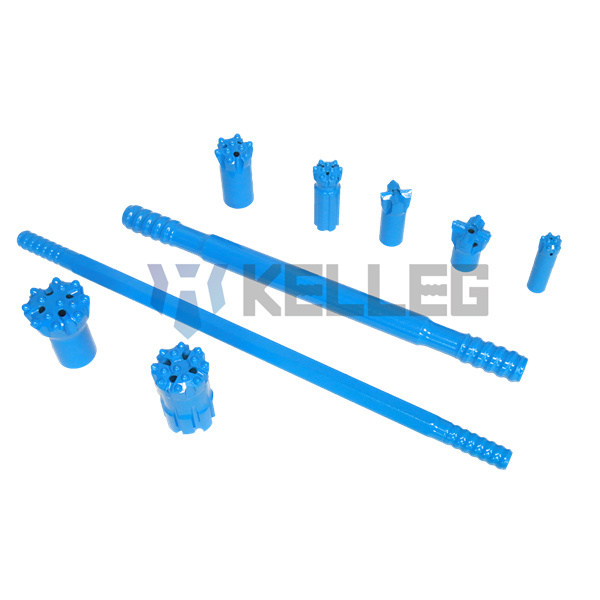2020 官网升级中!现在您访问官网的浏览器设备分辨率宽度低于1280px请使用高分辨率宽度访问。
The development of rock drilling equipment has promoted the development of rock drilling tools. Due to the harsh service conditions of rock drilling tools, coupled with the backward production equipment and manufacturing process of some manufacturers, the use of poor quality steel, and the lack of modern design methods and means. These reasons lead to unstable product quality, poor reliability, and even lower service life. Therefore, how to improve the service life of rock drilling tools is very important.

1. High-quality materials are the basis for improving the service life of rock drilling tools
According to the force analysis of rock drilling tools during the working process, the material of rock drilling tools must have good rigidity, high fatigue strength, low fatigue notch sensitivity, high clamping capacity of alloy pieces, good corrosion resistance, toughness, and wear resistance. Good manufacturing process, with strong hardenability, hardenability, and weldability. In addition, the hardness of the drill directly affects the service life of drill rods, so the quality of the hollow steel must be controlled when selecting materials. The hollow steel is required to have small dimensional tolerance, meet national requirements, good appearance, and have uniform hardness distribution.
2. Improve the structure
It is necessary to ensure that the geometric shape size and form tolerance of drill rods, especially the verticality of the end face and the straightness of rod should reach the national standard. To improve the profile shape, the transition area of drill rod collar plate and rod adopts compound arc transition, and the root of the threaded is designed as a transition arc receding force groove. Reduce the stress concentration and improve the ability to resist fatigue damage.
3. Improve manufacturing process and quality
In order to ensure the mechanical properties of drill bit and steel body, mechanical cutting of drill bit is required to improve the surface quality of the product and the accuracy of the tapered hole and thread. For small and medium cemented carbide rock drilling tools, while improving the quality of cemented carbide, steel, and welding materials, it is recommended to use a high-power, low-frequency, low-temperature bottom-sinking induction brazing process, which can effectively solidify the teeth. The surface of drill rod is heat treated, such as shot blasting, rolling, and anti-corrosion to improve the strength of the surface layer and reduce the fatigue notch sensitivity. The surface of drill bit should also be shot blasted, which can effectively reduce surface defects such as oxidation and decarburization, and improve fatigue resistance and wear resistance. Drill bit cone processing, zinc spraying, and aluminum spraying are conducive to a reliable connection, so that the brazing tip is in uniform contact with the trouser wall, eliminating stress concentration, effectively preventing the brazing head from expanding pants, cracking pants and brazing rod from breaking tips, and isolating the corrosion of the steel body of the hole wall by flushing water.
4. Grinding
Grinding or polishing the cemented carbide button on the rock drill bit can eliminate the microscopic cracks on the surface, significantly prolong the service life of drill bit, and also prolong the service life of drill rod, coupling sleeve, and shank adapter, reducing the failure of drill rod due to high internal stress, reducing the internal stress in other parts of the drilling equipment, increasing the drilling speed and drilling straighter. Generally, when the drilling speed is reduced, the diameter of the ground flat part of button on the head is close to or 1/3 of the diameter of button, an inverted cone and “snakeskin” appear, or the carbide is too protruding because drill bit is worn out, it needs to be grinding. Broken or otherwise damaged buttons must be ground off to prevent damage to other buttons by falling ballast.
5. Reasonable operation technology can effectively prolong the service life of rock drilling tools
The service life of rock drilling tools depends on their inherent quality and operational technology. Rocks form a series of discontinuities in different directions, laminations, joints, and faults during complex geological development. These physicomechanical differences require that the selection of rock drilling tools should achieve a reasonable match between rock properties, rock drills, and rock drilling tools. With reasonable operating techniques, early damage to rock drilling tools can be artificially reduced, thus effectively extending its service life. For example, the rock drill must have a suitable shaft thrust when drilling to ensure that drill bit is in stable contact with the rock, and drill bit should not be dismantled by hand pounding, and a special unloader should be used to unload the drill.